Abstract
With the development of mineral testing technology and ore deposit geochemistry, titanite has become a hot topic in the study of accessory minerals. Two large-grained titanite crystals from Mogok, Myanmar, were used for a detailed study. In this study, the standard gemmological properties and spectral characteristics of titanite crystals were obtained by Fourier transform in-frared, micro ultraviolet-visible-near-infrared and Raman spectroscopy, respectively, which pro-vide a full set of data. Mineral major and trace elements were analysed using Electron-Probe Mi-croAnalysis (EPMA) and Laser Ablation Inductively Coupled Plasma Mass Spectrometry (LA-ICP-MS). The purpose of this study is to report spectral characteristics and major and trace elements of Mogok, Myanmar, in order to find new potential titanite standard samples. The two titanite crystals have similar major element compositions, and both grains have relatively low Al content (0.011–0.014 apfu) and Al/Fe ratios (0.157–0.222), but high Fe content (0.063–0.079 apfu). The two titanite crystals have similar chondrite-normalised rare earth element (REE) patterns with significantly Light Rare Earth Element (LREE) (La–Gd) enrichment and deletion of Heavy Rare Earth Element (HREE) (Tb–Lu). The 238U/206Pb ages of the two titanite samples are 43.5 ± 5.8 Ma and 34.0 ± 4.2 Ma, respectively. Generally, magmatic titanite has a low Al/Fe ratio, metamorphic and hydrothermal titanite crystals have extremely low Th/U ratios close to zero, with flat chondrite-normalised REE patterns or depletions in light REEs relative to heavy REEs. Different genetic types of titanite can be distinguished by the characteristics of major and trace elements. Combined chemical features such as REE differentiation, Al/Fe and Th/U ratios with formation temperature, the analysed titanite samples are considered magmatic-hydrothermal titanites. Their 238U/206Pb ages may indicate a potential stage of magmatic hydrothermal conversion.
1. Introduction
Titanite (CaTiSiO5) is a common accessory mineral in various geological environments, including calc-alkalic plutonic rocks [1] (particularly I-type granites), metamorphic rocks [2] and hydrothermal products such as skarns [3]. The crystal structure of titanite is connected by SiO4 tetrahedron and TiO6 octahedron, and Ca2+ cations exist in the lattice with 7 coordination number [4]. The Ca2+ site can accommodate all large cations, including Y, rare earth elements (REEs), U, Th, Mn and Pb. These elements can indicate magmatic or hydrothermal evolution, which makes titanite a useful indicator of magma and/or fluid characteristics [5,6,7,8,9]. In addition, titanite is a good U–Th–Pb radiometric chronometer [10,11,12,13,14,15].
Recently, laser ablation multi-collector inductively coupled plasma mass spectrometry (LA-MC-ICP-MS) instrumentation has been widely used to determine the in situ major trace element and isotopic compositions of titanites [1,14,16,17,18,19,20,21,22,23,24,25,26,27,28]. However, the lack of matrix matching standard materials is a significant barrier to the widespread adoption of this technology [29].
In this study, in situ major trace element compositions of two titanite single crystals in Mogok, Myanmar, have been studied through electron probe microanalysis (EPMA) and LA-MC-ICP-MS. Spectral features are obtained and compared with the calibration spectra in the RRUFF database [30]. Our aims were to establish potential young titanite standard samples and reveal the genesis of titanite.
2. Geological Setting
The Mogok area in Myanmar is a world-famous gem-producing area (Figure 1a) [31,32,33], which, extending in the north–south direction, is primarily composed of metamorphic rocks, mixed rocks and late Mesozoic granitic intrusive rocks (Figure 1b) [34,35,36]. The Mogok metamorphic zone was formed by the northward subduction of the Indian plate in 71 Ma and the collision between the Eurasian and Indian plate at approximately 50 Ma [37]. Previous studies show that deep crustal melting occurred with ages ranging from 20–15 Ma in this region, and this process was accompanied by granite intrusion. Precious age determinations indicate that metamorphism along the MMB occurred during 68–21 Ma with peak between the Middle Eocene and the early Oligocene [38,39,40,41]. The Mogok titanite samples can meet the requirement of younger standard samples.
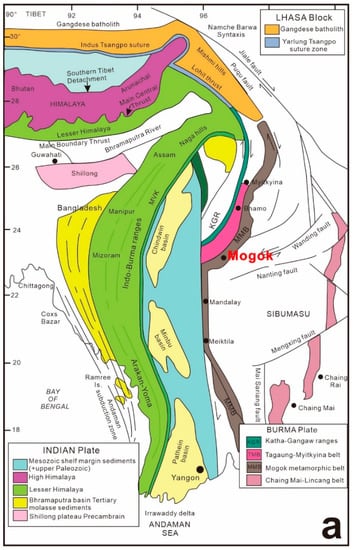
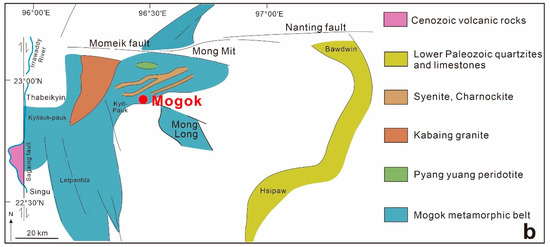
Figure 1.
Geological maps of Mogok metamorphic belt and adjacent regions (modified from Win et al., 2018) (a) [42]. The main geological structures for the Mogok area (modified from Searle et al., 2020) (b) [39].
3. Materials and Methods
Two Mogok titanite crystals (MG-5 and MG-6) were examined using standard gemmological techniques. The specific gravity (SG) of the samples was obtained using a hydrostatic weighing method. Spectroscopy tests for the samples were conducted at the Gemmological Research Laboratory of China University of Geosciences (Beijing) to obtain their spectral properties.
Infrared reflection spectra were obtained using the Tensor 27 Fourier transform infrared spectrometer, with a test spectral range of 2000–400 cm−1. An ultraviolet–visible (UV–Vis) spectroscopy test was conducted using a UV-3600 UV–Vis spectrophotometer (Shimadzu Corporation, Kyoto, Japan) to measure the absorption value with the following setting: slit width: 2.0 nm; time constant: 0.1 s; wavelength range (nm): 200.00–900.00; scanning speed: high speed; sampling interval: 0.5 A Horiba HR Evolution-type micro-confocal laser Raman spectrometer (Horiba, Ltd., Kyoto, Japan), which was used to conduct a Raman spectroscopy test with the following setting: laser source: 532 nm; slit width: 100 µm; grating: 600 gr/mm; scan time: 4 s; integration times: 3; ICS correction range: 100–2000 cm−1.
The titanite grains were mounted in epoxy, polished and examined using BSE images to select suitable targets for in situ analysis. The TESCAN field emission scanning electron microscope (MIRA 3LMH) was used to capture BSE images with the following setting: acceleration voltage: 7 kV; absorption current: 1.2 Na; scan time: 80 s.
Electron-Probe MicroAnalysis (EPMA) was conducted in the Laboratory of EPMA, China University of Geosciences (Beijing) with the following setting: acceleration voltage: 15 kV; electic current: 10 Na; beam spot diameter: 1 μm.
An Agilent 7900 Q-ICP-MS instrument coupled to a 193-nm ArF excimer laser ablation system was used to determine trace element compositions and U–Pb ages in the Laboratory of Mineral Laser Microzone Analysis, China University of Geosciences (Beijing). The Ontario standard was used for calibration, and the MKED1 standard was used as a standard reference.
4. Results
4.1. Visual Appearance and Gemmological Properties
The titanite samples are dark brown and translucent with medium cleavage and greasy lustre (Figure 2a,b). The MG-6 sample has crystal plane steps. Triangular etching on the crystal surface can also be observed. Some weak areas of MG-5 sample are dissolved into small pits by corrosion, forming regular shaped pits on the crystal surface (Figure 3).
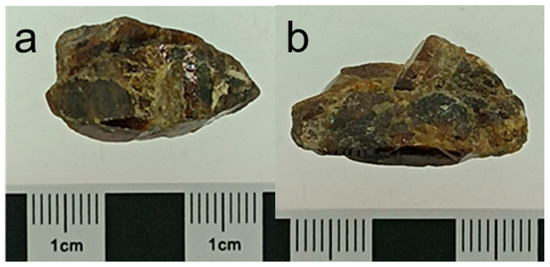
Figure 2.
The titanite crystals of MG-5 (a) and MG-6 (b).
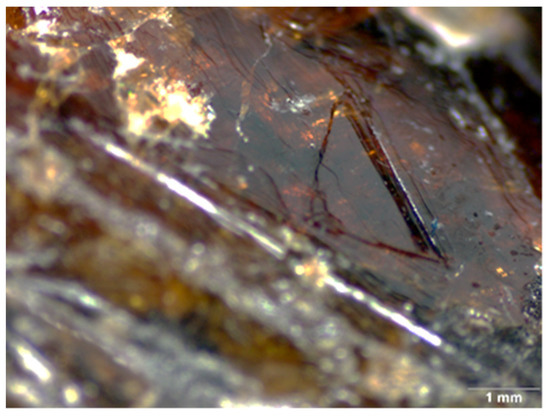
Figure 3.
Triangular etching of MG-5.
The SG values of MG-5 and MG-6 are 3.51 and 3.56, respectively. Since the refractive index of titanite varied between 1.89 and 2.02, the index of refraction exceeded the refractometer’s value and could not be measured. The titanite samples do not change colour under a Chelsea colour filter. The titanite samples have a rare earth spectrum, as seen through spectroscopes, with multiple fine absorption lines and 580 nm double lines.
4.2. Spectral Characteristics
4.2.1. Fourier Transform Infrared Spectrum
The MG-5 and MG-6 samples have 432.04, 565.12, 725.21 and 939.30 cm−1 characteristic absorption peaks in the fingerprint region (Figure 4). The position of 420–440 cm−1 is the vibration band of TiO6 octahedron. The position of 550–570 cm−1 is the in-plane bending vibration band of SiO44− and Si–O bond; the position of 730 cm−1 is the stretching vibration band of Si–Si bond; and 800–1000 cm−1 is the position of the asymmetric stretching vibration band of the Si–O bond and triple simplification of SiO44−.

Figure 4.
Fourier Transform Infrared Spectrum of MG-5 and MG-6.
4.2.2. UV–Vis Spectrum
The colour origin of the titanite samples was analysed by UV–Vis spectra. MG-5 and MG-6 are brown titanite samples. The UV–Vis spectrum of MG-6 has an obvious absorption peak centred at 565 nm in the range of 550–600 nm, weak absorption peaks at 700–800 nm and a wide and slow absorption band at 220–300 nm (Figure 5). The yellow–green absorption band with 565 nm as the centre in the range of 550–600 nm is caused by the electron transition between Ti4+ and Fe4+.
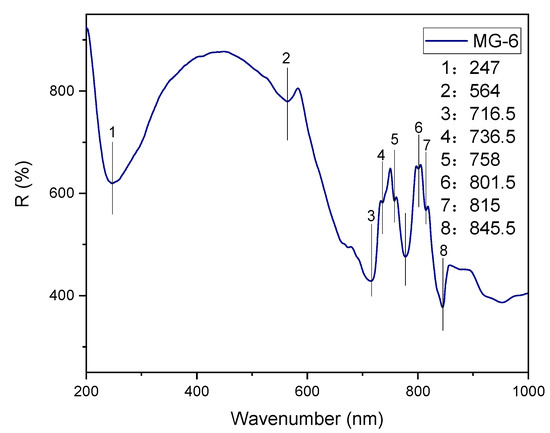
Figure 5.
UV–Vis spectrum of MG-6.
4.2.3. Raman Spectrum
The following characteristic peaks of the titanite samples are found within the range of 200–2000 cm−1: an absorption peak at 242 cm−1 caused by the translational vibration of [SiO4]4+, an absorption peak at 316 cm−1 caused by the rotational vibration of [SiO4]4+, an absorption peak at 467 cm−1 caused by the bending vibration of [SiO4]4+, a strong absorption peak at 605 cm−1 and an absorption peak at 854 cm−1 both caused by the stretching vibration of [SiO4]4+ (Figure 6).
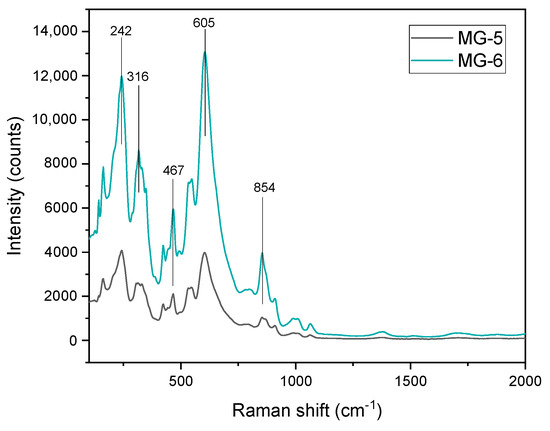
Figure 6.
Raman spectra of MG-5 and MG-6.
4.3. Major and Trace Elements
Major element compositions of the titanite samples are presented in Table A1. The two titanite crystals have similar major element compositions (CaO 25.93–27.61 wt%, TiO2 36.67–38.25 wt% and SiO2 29.50–30.47 wt%). Both grains show relatively low Al contents (0.15–0.18 apfu) and low Al/Fe ratios (0.07–0.08), but high Fe content (1.77–2.22 apfu).
Forty analyses were conducted on the two titanite grains by LA-MC-ICP-MS. The trace element compositions are listed in Table A2 and Table A3 Titanite is an essential sink of the entire rock [43], Nb, Ta, Th and U (Nb: 203.6–846.8 ppm; Ta: 2.181–19.23 ppm; Th: 0.892–3.412 ppm; U: 0.6871–3 ppm), and is commonly enriched with LREEs. The two titanite crystals have similar chondrite-normalised REE patterns with moderate REE concentrations (REE: 1896–2857 ppm). They have significantly LREE enrichment and deletion of HREE (LREE/HREE: 6.55–10.39) (Figure 7a,b).
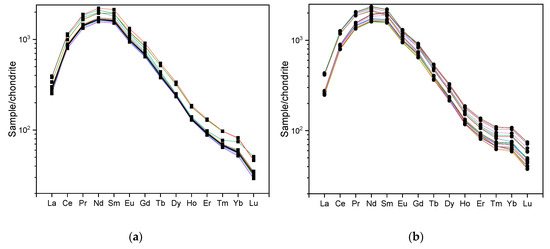
Figure 7.
Chondrite-normalised REE patterns of titanite samples MG-5 (a) and MG-6 (b). Chondrite REE values from McDonough, W.F. and Sun, S.S. (1995) [44]. Lines with different colors represent data of different spots in measurement by LA-ICP-MS.
Previous studies have demonstrated that REEs replace Ca and Zr in titanite and high field strength elements such as Nd will displace Ti (Al, Fe) in the titanite lattice. The positive correlation of Nd–Zr in the samples shows that the two elements exhibit the same substitution characteristics (Figure 8).
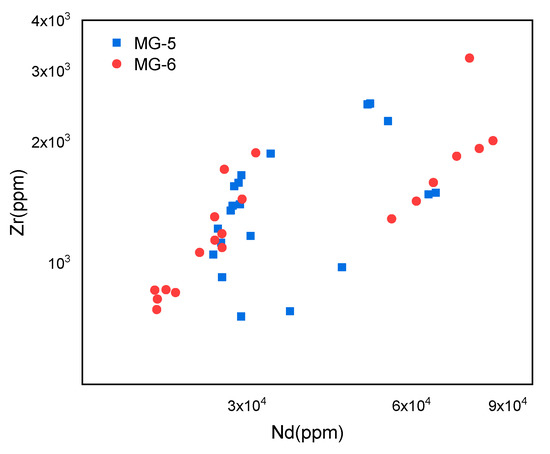
Figure 8.
Correlations between Nd (ppm) and Zr (ppm) of titanites.
4.4. Titanite U–Pb Ages
The titanite ages with common Pb [45] were calculated using the weighted mean of the 207Pb-corrected ages and the Tera–Wasserberg (TW) Concordia intercept age anchored through common Pb. Titanite U–Pb isotope results and ages are listed in Table A4 and Table A5. Overall 20 LA-ICP-MS analyses of each titanite sample were performed in different sections (Figure 9a,b). On the TW diagram, the common Pb-uncorrected data of MG-5 define a linear array, yielding a lower-intercept age of 44 ± 17 Ma (n = 20, 2σ, MSWD = 0.63) and a y-intercept of initial 207Pb/206Pb of 0.848 (Figure 10a,b). The common Pb-uncorrected data of MG-6 define a linear array, yielding a lower-intercept age of 34 ± 14 Ma (n = 20, 2σ, MSWD = 0.75) and a y-intercept of initial 207Pb/206Pb of 0.843 (Figure 10c,d). On the basis of this common Pb composition, a common Pb correction was performed using the method of fitting 207Pb/206Pbc. All analyses of MG-5 yielded a weighted average 206Pb/238U age of 43.5 ± 5.8 Ma (n = 20, 2σ, MSWD = 0.57), and those of MG-6 yielded a weighted average 206Pb/238U age of 34.0 ± 4.2 Ma (n = 20, 2σ, MSWD = 0.65).

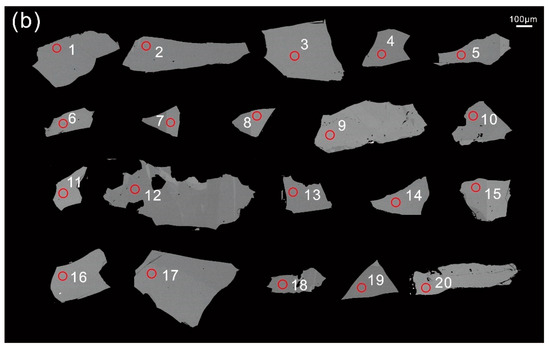
Figure 9.
Backscattered electron images of the Mogok titanites MG-5 (a) and MG-6 (b). Red circles show positions for simultaneous LA-ICP-MS measurements of U–Pb ages. 206Pb/238U ages are in red.
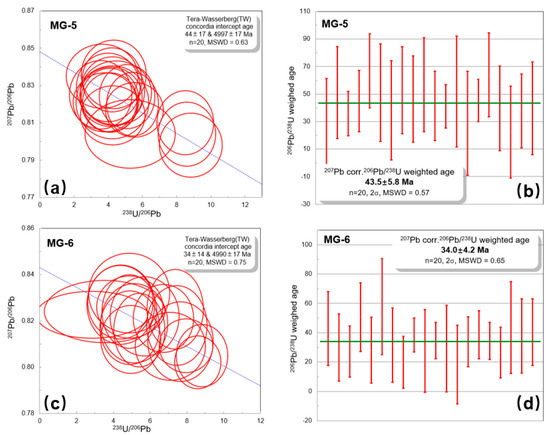
Figure 10.
LA-ICP-MS titanite U–Pb TW diagram (a) and 206Pb/238U weighed age for MG-5 (b); LA-ICP-MS titanite U–Pb TW diagram (c) and 206Pb/238U weighed age for MG-6 (d).
5. Discussion
5.1. Comparision with RRUFF Database
The RRUFF database contains eight titanite standard samples from Brazil, the USA, Pakistan, Canada and Mexico. R050114 with yellowish-brown fragments from Pakistan was chosen for comparison. Fourier transform infrared spectra of titanite R050114 have 416.5, 559.3 and 848.5 cm−1 characteristic absorption peaks in the fingerprint region (Figure 11), indicating that these characteristic peaks occur in the range of peaks caused by different bonds; however, the positions of these characteristic peaks are different. Raman spectra of titanite R050114 have 252, 316, 423, 605, 873, 880 and 1177cm−1 characteristic peaks (Figure 12). The characteristic peak at 605 cm−1 is consistent with that of the analysed samples MG-5 and MG-6.
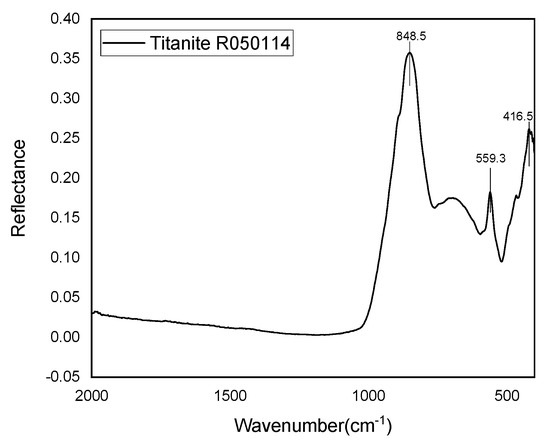
Figure 11.
Fourier transform infrared spectrum of titanite R050114 from RRUFF database.
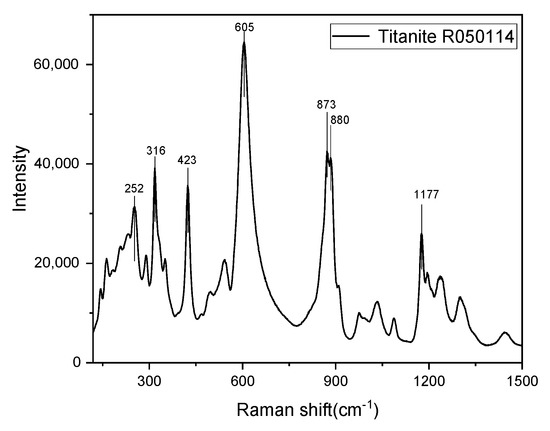
Figure 12.
Raman spectrum of titanite R050114 from RRUFF database.
Raman spectra of common titanite reference samples are shown in Figure 13 [46]. All samples exhibited characteristic peaks near 255, 316, 342 and 850 cm−1, similar to analysed samples MG-5 and MG-6. The Raman spectra of the YQ82, BMB108 and MKED1 samples are similar, with characteristic peaks at 162, 231, 250, 540, 606 and 911 cm−1. The Raman spectra of the BLR-1, Ontario and OLT1 titanite samples are similar, with characteristic peaks at 573 and 650 cm−1. Bands occurred near 575 and 611 cm−1 in the Khan titanite, rendering this an intermediate sample between the above two groups.
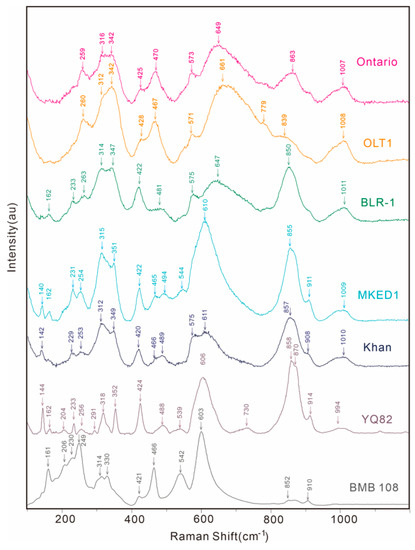
Figure 13.
Raman spectra of common titanite reference samples (modified from a part of Figure 3 of Ling X-X et al., 2022) [46].
5.2. Formation Temperature of Titanite
The Al2O3 content of titanite was used to estimate the formation pressure of titanite [47], and a pressure-dependent Zr in titanite geothermometer [48] was used to estimate the formation temperature of titanite. High temperatures enable more Zr to enter the structure of titanite. The Al2O3 content of titanite increases with pressure (P) according to the following: P (in MPa) = 101.66 × Al2O3 in titanite (in wt%) + 59.013 (R2 = 0.83). The pressures of MG-5 were estimated to be 88.39–92.15 Mpa (average = 90.14 Mpa, n = 10), and those of MG-6 were estimated to be 86.56–94.80 Mpa (average = 92.04 Mpa, n = 10). According to the studies by Hayden et al. (2008), αTiO2 = αSiO2 = 1. The Zr in titanite temperatures of MG-5 were estimated to be 466.5–467.1 °C (average = 466.79 °C, n = 20), and those of MG-6 were estimated to be 466.6–467.2 °C (average = 466.98 °C, n = 20).
Along with the weighted average 206Pb/238U ages of these two samples, the calculated temperature range is consistent with the geological background of their ages (Figure 14). However, there is a significant difference in the calculation results of temperature, which may be caused by the inaccuracy of cogenetic minerals in the calculation formula.
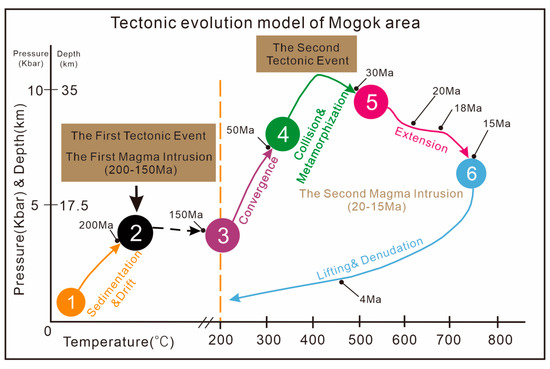
Figure 14.
Tectonic evolution model of Mogok area (modified from Themelis et al., 2008) [37].
5.3. Genesis of Analysed Titanite
The classification of the genetic types of titanite requires comprehensive consideration of the major and trace elements. In general, magmatic titanite has a low Al/Fe ratio, whereas metamorphic titanite, including hydrothermal titanite, has a high Al/Fe ratio. Both grains have been plotted in the igneous field of Kowallis et al. (1997) (Figure 15).
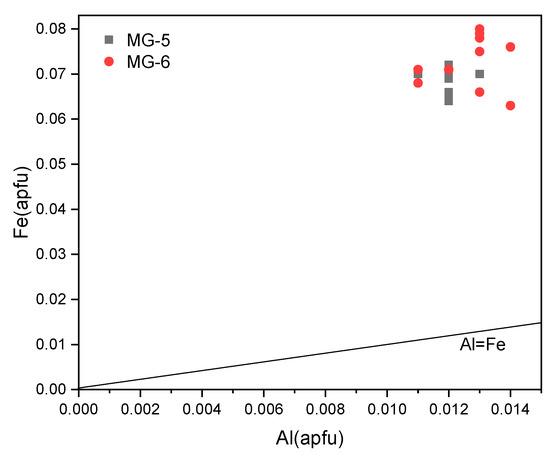
Figure 15.
Fe vs. Al cations per formula unit.
Metamorphic and hydrothermal titanite crystals commonly have extremely low Th/U ratios close to zero, along with flat chondrite-normalised REE patterns or depletions in light REEs relative to heavy REEs. In contrast, two analysed titanite grains show heavy light REE (La–Gd) to weak heavy REEs (Tb–Lu) differentiation [49].
The Th/U ratio is also an indicator of the origin of titanite. In general, hydrothermal titanite has a lower ratio of Th/U (mostly < 1) than magmatic titanite. In this study, the two samples yielded a similar ratio of Th/U (MG-5: 1.30–1.92; average: 1.61; MG-6: 1.08–1.57; average: 1.37). Thus, titanite that crystallises under high-temperature hydrothermal conditions would also have the characteristics of magmatic titanite Th/U > 1. To discriminate the origin of titanite using a single ratio of Th/U indicator is inaccurate.
However, considering that the calculated formation temperatures were lower and consistent with that of the hydrothermally modified titanite, EMPA data have shown low concentrations of La in the analysed titanite samples (Table A5), which is commonly related to late hydrothermal activity [50], and our samples can be recognized as products of magmatic hydrothermal conversion [27,51,52].
Analysed titanite samples are interpreted as magmatic-hydrothermal.
5.4. Tectonic Evolutionary History
Themelis (2007) divides the geological evolution of Mogok into six important stages: deposit, continental drift, plate convergence, continental plate collision, post-collisional extension, lifting and erosion (Figure 14). The continental plate collision occurred between 50 Ma and 30 Ma, and the Northeastern Indian plate subducted obliquely into the Eastern Asian plate. Continental collisions and the drift and collision of other microland masses continue today. The weighted average 206Pb/238U ages of the two titanite crystals are determined as 43.5 ± 5.8 Ma and 34.0 ± 4.2 Ma, respectively, limiting the formation age of titanite in the period of continental plate collision.
6. Conclusions
We have investigated the chemical composition, structure and genesis of titanite crystals from Mogok, Myanmar, through Fourier infrared, UV–Vis and Raman spectroscopy, EPMA and LA-MC-ICP-MS. These results are used to assess the potential of titanite as reference material for micro-analytical dating. In this paper, the analysis and summary of mineralogical and spectral characteristics based on the samples provide characteristics of a new production area of titanite not found in the RURFF database. According to U–Pb dating analysis, age data have a high concordant degree with weighted average 206Pb/238U ages 43.5 ± 5.8 Ma and 34.0 ± 4.2 Ma, respectively, which indicates the potential stage of magmatic hydrothermal conversion. Thus, these two grains can be used as potential stand samples for U–Pb dating analysis. Major and trace element analyses of titanites can be used to discuss the genetic type and explore their geological background.
Author Contributions
Writing and experimental data processing, J.G.; writing—review and editing, B.X., S.L. and Y.Z.; methodology, B.X.; software, J.G. and S.L. All authors have read and agreed to the published version of the manuscript.
Funding
This research was funded by National Key Technologies R&D Program (2020YFA0714800, 2019YFA0708602); National Natural Science Foundation of China (42073038, 41803045), Young Talent Support Project of CAST, the Fundamental Research Funds for the Central Universities (Grant no. 265QZ2021012), and IGCP-662.
Data Availability Statement
The data presented in this study are available within this article.
Acknowledgments
We thank the editor and reviewers for constructive comments which helped in improving our paper. This is the 8th contribution of B.X. for the National Mineral Rock and Fossil Specimens Resource Center.
Conflicts of Interest
The authors declare no conflict of interest.
Appendix A

Table A1.
Chemical compositions with the structural formulas of analysed titanite from Mogok analysed by EMPA (wt.%).
Table A1.
Chemical compositions with the structural formulas of analysed titanite from Mogok analysed by EMPA (wt.%).
| MG-5-1 | MG-5-2 | MG-5-3 | MG-5-4 | MG-5-5 | MG-5-6 | MG-5-7 | MG-5-8 | MG-5-9 | MG-5-10 | MG-6-1 | MG-6-2 | MG-6-3 | MG-6-4 | MG-6-5 | MG-6-6 | MG-6-7 | MG-6-8 | MG-6-9 | MG-6-10 | |||||
|---|---|---|---|---|---|---|---|---|---|---|---|---|---|---|---|---|---|---|---|---|---|---|---|---|
| SiO2 | 29.904 | 30.071 | 29.686 | 29.504 | 30.033 | 30.125 | 29.555 | 29.954 | 29.962 | 30.069 | 30.219 | 30.094 | 30.177 | 29.889 | 29.779 | 30.47 | 29.619 | 29.733 | 29.979 | 30.032 | ||||
| TiO2 | 37.147 | 36.929 | 38.246 | 38.016 | 37.133 | 38.153 | 37.695 | 38.016 | 37.371 | 37.324 | 37.037 | 36.668 | 37.176 | 37.662 | 37.977 | 37.417 | 37.951 | 37.224 | 37.099 | 37.497 | ||||
| Al2O3 | 0.308 | 0.303 | 0.326 | 0.312 | 0.301 | 0.308 | 0.31 | 0.304 | 0.289 | 0.301 | 0.277 | 0.343 | 0.331 | 0.348 | 0.342 | 0.352 | 0.271 | 0.338 | 0.334 | 0.313 | ||||
| FeO | 2.488 | 2.322 | 2.533 | 2.587 | 2.299 | 2.567 | 2.456 | 2.353 | 2.485 | 2.308 | 2.554 | 2.811 | 2.825 | 2.722 | 2.364 | 2.283 | 2.405 | 2.855 | 2.669 | 2.547 | ||||
| MnO | 0.044 | 0.014 | 0.039 | 0 | 0 | 0 | 0 | 0 | 0.004 | 0.092 | 0.012 | 0 | 0.016 | 0.014 | 0.025 | 0.045 | 0.143 | 0 | 0 | 0.131 | ||||
| MgO | 0.029 | 0.008 | 0.042 | 0.009 | 0 | 0.01 | 0.012 | 0.008 | 0.019 | 0.029 | 0.036 | 0.017 | 0.025 | 0.021 | 0.009 | 0.024 | 0.013 | 0.037 | 0.028 | 0.005 | ||||
| CaO | 26.839 | 27.075 | 26.363 | 26.559 | 26.748 | 26.477 | 27.119 | 26.459 | 26.519 | 26.578 | 26.994 | 27.612 | 26.707 | 27.065 | 26.553 | 26.376 | 26.583 | 26.259 | 25.928 | 26.975 | ||||
| Na2O | 0.431 | 0.44 | 0.552 | 0.518 | 0.441 | 0.43 | 0.388 | 0.422 | 0.425 | 0.44 | 0.381 | 0.343 | 0.413 | 0.369 | 0.599 | 0.511 | 0.393 | 0.456 | 0.591 | 0.345 | ||||
| K2O | 0.013 | 0 | 0.007 | 0.009 | 0.008 | 0 | 0.014 | 0.005 | 0.002 | 0.018 | 0.001 | 0.007 | 0.012 | 0.02 | 0 | 0.014 | 0.006 | 0.008 | 0.02 | 0.002 | ||||
| F | 0.179 | 0.131 | 0.151 | 0.13 | 0.377 | 0.097 | 0.193 | 0.172 | 0.22 | 0.213 | 0.248 | 0.315 | 0.001 | 0.001 | 0.14 | 0.21 | 0.013 | 0.396 | 0.049 | 0.055 | ||||
| Cr2O3 | 0.008 | 0 | 0 | 0 | 0.036 | 0 | 0 | 0 | 0.016 | 0.081 | 0 | 0.028 | 0.007 | 0 | 0 | 0.055 | 0 | 0.025 | 0 | 0 | ||||
| NiO | 0.035 | 0.009 | 0 | 0.067 | 0.078 | 0.057 | 0.051 | 0.002 | 0 | 0 | 0.016 | 0 | 0 | 0 | 0.019 | 0.066 | 0 | 0.028 | 0.079 | 0.073 | ||||
| V2O5 | 0.385 | 0.485 | 0.522 | 0.422 | 0.358 | 0.333 | 0.383 | 0.477 | 0.4 | 0.363 | 0.521 | 0.447 | 0.488 | 0.377 | 0.371 | 0.52 | 0.332 | 0.522 | 0.415 | 0.458 | ||||
| La2O3 | 0 | 0.033 | 0 | 0.064 | 0 | 0 | 0 | 0 | 0.104 | 0 | 0 | 0.007 | 0 | 0 | 0 | 0.141 | 0.007 | 0.097 | 0 | 0 | ||||
| Ce2O3 | 0.816 | 0.9 | 1.193 | 1.414 | 0.918 | 0.705 | 0.918 | 0.997 | 0.891 | 1.092 | 0.768 | 0.948 | 0.833 | 0.985 | 1.195 | 1.097 | 0.958 | 0.736 | 1.089 | 1.062 | ||||
| Total | 98.627 | 98.719 | 99.66 | 99.612 | 98.73 | 99.26 | 99.095 | 99.169 | 98.709 | 98.906 | 99.066 | 99.642 | 99.01 | 99.472 | 99.373 | 99.58 | 98.696 | 98.714 | 98.28 | 99.495 | ||||
| Cations (apfu) | ||||||||||||||||||||||||
| Si | 1.003 | 1.008 | 0.988 | 0.986 | 1.003 | 1.002 | 0.988 | 0.998 | 1.003 | 1.005 | 1.007 | 1.001 | 1.010 | 0.998 | 0.993 | 1.011 | 0.995 | 0.995 | 1.011 | 1.002 | ||||
| Al | 0.012 | 0.012 | 0.013 | 0.012 | 0.012 | 0.012 | 0.012 | 0.012 | 0.011 | 0.012 | 0.011 | 0.013 | 0.013 | 0.014 | 0.013 | 0.014 | 0.011 | 0.013 | 0.013 | 0.012 | ||||
| Ti | 0.937 | 0.931 | 0.957 | 0.955 | 0.933 | 0.955 | 0.948 | 0.953 | 0.941 | 0.938 | 0.929 | 0.917 | 0.936 | 0.946 | 0.953 | 0.934 | 0.959 | 0.937 | 0.941 | 0.941 | ||||
| Fe | 0.070 | 0.065 | 0.070 | 0.072 | 0.064 | 0.071 | 0.069 | 0.066 | 0.070 | 0.065 | 0.071 | 0.078 | 0.079 | 0.076 | 0.066 | 0.063 | 0.068 | 0.080 | 0.075 | 0.071 | ||||
| Mn | 0.001 | 0.000 | 0.001 | 0.000 | 0.000 | 0.000 | 0.000 | 0.000 | 0.000 | 0.003 | 0.000 | 0.000 | 0.000 | 0.000 | 0.001 | 0.001 | 0.004 | 0.000 | 0.000 | 0.004 | ||||
| Mg | 0.001 | 0.000 | 0.002 | 0.000 | 0.000 | 0.000 | 0.001 | 0.000 | 0.001 | 0.001 | 0.002 | 0.001 | 0.001 | 0.001 | 0.000 | 0.001 | 0.001 | 0.002 | 0.001 | 0.000 | ||||
| Ca | 0.964 | 0.972 | 0.940 | 0.951 | 0.957 | 0.944 | 0.972 | 0.945 | 0.951 | 0.952 | 0.964 | 0.984 | 0.958 | 0.968 | 0.949 | 0.938 | 0.957 | 0.941 | 0.936 | 0.964 | ||||
| Na | 0.028 | 0.029 | 0.036 | 0.034 | 0.029 | 0.028 | 0.025 | 0.027 | 0.028 | 0.029 | 0.025 | 0.022 | 0.027 | 0.024 | 0.039 | 0.033 | 0.026 | 0.030 | 0.039 | 0.022 | ||||
| K | 0.001 | 0.000 | 0.000 | 0.000 | 0.000 | 0.000 | 0.001 | 0.000 | 0.000 | 0.001 | 0.000 | 0.000 | 0.001 | 0.001 | 0.000 | 0.001 | 0.000 | 0.000 | 0.001 | 0.000 | ||||
| F | 0.019 | 0.014 | 0.016 | 0.014 | 0.040 | 0.010 | 0.020 | 0.018 | 0.023 | 0.023 | 0.026 | 0.033 | 0.000 | 0.000 | 0.015 | 0.022 | 0.001 | 0.042 | 0.005 | 0.006 | ||||
| Cr | 0.000 | 0.000 | 0.000 | 0.000 | 0.001 | 0.000 | 0.000 | 0.000 | 0.000 | 0.002 | 0.000 | 0.001 | 0.000 | 0.000 | 0.000 | 0.001 | 0.000 | 0.001 | 0.000 | 0.000 | ||||
| Ni | 0.001 | 0.000 | 0.000 | 0.002 | 0.002 | 0.002 | 0.001 | 0.000 | 0.000 | 0.000 | 0.000 | 0.000 | 0.000 | 0.000 | 0.001 | 0.002 | 0.000 | 0.001 | 0.002 | 0.002 | ||||
| V | 0.010 | 0.013 | 0.014 | 0.011 | 0.010 | 0.009 | 0.010 | 0.013 | 0.011 | 0.010 | 0.014 | 0.012 | 0.013 | 0.010 | 0.010 | 0.014 | 0.009 | 0.014 | 0.011 | 0.012 | ||||
| La | 0.000 | 0.000 | 0.000 | 0.001 | 0.000 | 0.000 | 0.000 | 0.000 | 0.001 | 0.000 | 0.000 | 0.000 | 0.000 | 0.000 | 0.000 | 0.002 | 0.000 | 0.001 | 0.000 | 0.000 | ||||
| Ce | 0.010 | 0.011 | 0.015 | 0.017 | 0.011 | 0.009 | 0.011 | 0.012 | 0.011 | 0.013 | 0.009 | 0.012 | 0.010 | 0.012 | 0.015 | 0.013 | 0.012 | 0.009 | 0.013 | 0.013 | ||||

Table A2.
Rare earth element content (ppm) of MG-5.
Table A2.
Rare earth element content (ppm) of MG-5.
| La | Ce | Pr | Nd | Sm | Eu | Gd | Tb | Dy | Ho | Er | Tm | Yb | Lu | |
|---|---|---|---|---|---|---|---|---|---|---|---|---|---|---|
| MG-5-1 | 66.78 | 517.4 | 129.8 | 748.5 | 232.6 | 54.66 | 132.7 | 14.26 | 58.06 | 7.215 | 14.68 | 1.648 | 8.94 | 0.784 |
| MG-5-2 | 67.10 | 522.8 | 131.1 | 758.9 | 237.6 | 55.37 | 135.7 | 14.46 | 59.12 | 7.359 | 14.94 | 1.699 | 9.23 | 0.8233 |
| MG-5-3 | 79.89 | 607.7 | 153.2 | 889.1 | 284.8 | 67.84 | 166.3 | 18.67 | 78.31 | 9.806 | 20.55 | 2.386 | 13.09 | 1.138 |
| MG-5-4 | 92.81 | 703.2 | 171.2 | 961 | 287 | 65.01 | 155.9 | 15.83 | 61.89 | 7.636 | 15.64 | 1.899 | 11.99 | 1.252 |
| MG-5-5 | 68.72 | 531.4 | 133.7 | 773.9 | 240.7 | 56.22 | 135.8 | 14.50 | 59.56 | 7.355 | 14.83 | 1.693 | 9.33 | 0.8161 |
| MG-5-6 | 66.88 | 515.4 | 129.9 | 753.2 | 235.6 | 54.84 | 134.1 | 14.24 | 58.14 | 7.236 | 14.74 | 1.668 | 9.10 | 0.811 |
| MG-5-7 | 65.41 | 508.4 | 127.9 | 737.4 | 229.5 | 53.79 | 130.3 | 13.91 | 57.4 | 7.081 | 14.29 | 1.615 | 8.74 | 0.760 |
| MG-5-8 | 67.35 | 519.0 | 130.2 | 758.4 | 235.4 | 55.19 | 135.2 | 14.35 | 58.74 | 7.289 | 14.82 | 1.67 | 9.13 | 0.803 |
| MG-5-9 | 67.61 | 519.7 | 130.3 | 757.1 | 236.3 | 55.28 | 134.6 | 14.36 | 59.14 | 7.294 | 14.79 | 1.663 | 9.11 | 0.794 |
| MG-5-10 | 70.98 | 544.2 | 136.0 | 791.1 | 245.1 | 57.46 | 140.3 | 14.82 | 60.63 | 7.495 | 15.27 | 1.732 | 9.55 | 0.840 |
| MG-5-11 | 93.26 | 674.7 | 162.5 | 909.4 | 267.1 | 61.19 | 145.5 | 15.14 | 61.63 | 7.506 | 15.04 | 1.707 | 9.35 | 0.811 |
| MG-5-12 | 80.34 | 609.1 | 153.9 | 896.5 | 285.6 | 68.46 | 167.7 | 18.58 | 79.41 | 9.865 | 20.67 | 2.389 | 13.22 | 1.149 |
| MG-5-13 | 63.76 | 487.2 | 122.8 | 715.7 | 223.8 | 52.57 | 127.8 | 13.66 | 57.27 | 7.033 | 14.04 | 1.585 | 8.35 | 0.716 |
| MG-5-14 | 59.66 | 502.9 | 133.4 | 790.6 | 250.9 | 58.18 | 140.9 | 14.66 | 60.32 | 7.334 | 14.90 | 1.707 | 9.725 | 0.858 |
| MG-5-15 | 90.41 | 691.7 | 174.7 | 1009.9 | 315.2 | 74.28 | 180.9 | 19.63 | 82.84 | 10.171 | 21.08 | 2.400 | 13.2 | 1.147 |
| MG-5-16 | 66.65 | 514.6 | 129.7 | 754.0 | 234.7 | 54.88 | 134.0 | 14.17 | 58.94 | 7.210 | 14.70 | 1.656 | 9.02 | 0.7811 |
| MG-5-17 | 69.77 | 532.1 | 133.5 | 770.0 | 237.2 | 55.29 | 135.0 | 14.13 | 58.25 | 7.104 | 14.56 | 1.658 | 9.19 | 0.824 |
| MG-5-18 | 67.59 | 524.5 | 131.8 | 768.8 | 238.9 | 55.65 | 135.6 | 14.30 | 59.27 | 7.290 | 14.80 | 1.687 | 9.28 | 0.819 |
| MG-5-19 | 99.32 | 715.4 | 171.3 | 957.5 | 282.4 | 65.35 | 155.4 | 16.18 | 66.19 | 7.979 | 16.02 | 1.782 | 9.56 | 0.817 |
| MG-5-20 | 67.54 | 523.6 | 132.1 | 771.0 | 240.0 | 55.87 | 137.2 | 14.40 | 59.43 | 7.316 | 14.87 | 1.689 | 9.266 | 0.816 |

Table A3.
Rare earth element content (ppm) of MG-6.
Table A3.
Rare earth element content (ppm) of MG-6.
| La | Ce | Pr | Nd | Sm | Eu | Gd | Tb | Dy | Ho | Er | Tm | Yb | Lu | |
|---|---|---|---|---|---|---|---|---|---|---|---|---|---|---|
| MG-6-1 | 64.07 | 522.5 | 134.4 | 785.6 | 247.7 | 56.53 | 138.2 | 13.95 | 55.57 | 6.881 | 14.22 | 1.753 | 11.38 | 1.210 |
| MG-6-2 | 58.69 | 484.0 | 125.8 | 748.5 | 241.3 | 55.56 | 137.0 | 14.05 | 57.23 | 7.093 | 14.85 | 1.845 | 11.79 | 1.217 |
| MG-6-3 | 64.10 | 543.8 | 144.7 | 885.8 | 300.4 | 71.00 | 180.8 | 19.23 | 79.70 | 9.980 | 21.35 | 2.666 | 17.2 | 1.819 |
| MG-6-4 | 59.31 | 486.6 | 126.0 | 743.1 | 239.8 | 55.22 | 136.0 | 13.90 | 56.39 | 7.065 | 14.76 | 1.817 | 11.69 | 1.223 |
| MG-6-5 | 102.70 | 761.7 | 182.3 | 997.2 | 283.4 | 61.75 | 144.4 | 13.94 | 53.83 | 6.420 | 12.96 | 1.563 | 9.71 | 0.982 |
| MG-6-6 | 99.27 | 729.9 | 174.0 | 958.5 | 273.7 | 59.93 | 140.7 | 13.69 | 53.40 | 6.378 | 12.87 | 1.534 | 9.43 | 0.922 |
| MG-6-7 | 65.05 | 531.1 | 135.3 | 798.2 | 251.6 | 57.47 | 140.8 | 14.33 | 57.05 | 7.066 | 14.63 | 1.782 | 11.38 | 1.182 |
| MG-6-8 | 64.43 | 541.9 | 143.1 | 873.7 | 297.0 | 69.64 | 177.0 | 18.73 | 77.45 | 9.675 | 20.75 | 2.557 | 16.61 | 1.749 |
| MG-6-9 | 101.66 | 763.8 | 185.2 | 1039.0 | 307.5 | 69.15 | 164.6 | 16.72 | 67.20 | 8.235 | 16.96 | 2.022 | 12.18 | 1.167 |
| MG-6-10 | 61.39 | 498.6 | 128.6 | 759.1 | 241.2 | 55.76 | 137.2 | 14.13 | 57.80 | 7.274 | 15.01 | 1.811 | 11.07 | 1.112 |
| MG-6-11 | 101.31 | 761.5 | 185.2 | 1034.5 | 307.7 | 69.18 | 164.6 | 16.84 | 67.66 | 8.280 | 17.04 | 2.031 | 12.13 | 1.184 |
| MG-6-12 | 59.55 | 484.7 | 124.2 | 731.5 | 230.2 | 52.96 | 127.7 | 13.11 | 53.24 | 6.633 | 13.68 | 1.654 | 10.06 | 0.988 |
| MG-6-13 | 60.03 | 491.6 | 125.8 | 738.4 | 233.8 | 53.56 | 129.6 | 13.14 | 52.68 | 6.516 | 13.44 | 1.65 | 10.52 | 1.080 |
| MG-6-14 | 65.50 | 550.3 | 145.4 | 890.2 | 303.7 | 71.89 | 183.2 | 19.55 | 80.81 | 10.215 | 21.87 | 2.715 | 17.39 | 1.836 |
| MG-6-15 | 100.36 | 769.8 | 188.8 | 1067.0 | 321.5 | 72.25 | 171.4 | 17.3 | 68.59 | 8.308 | 17.17 | 2.124 | 13.81 | 1.43 |
| MG-6-16 | 101.48 | 778.1 | 191.1 | 1079.0 | 326.0 | 73.59 | 175.4 | 17.87 | 71.09 | 8.629 | 17.82 | 2.208 | 14.06 | 1.454 |
| MG-6-17 | 63.18 | 526.9 | 138.6 | 841.2 | 280.5 | 65.76 | 166.2 | 17.47 | 72.07 | 9.016 | 18.81 | 2.345 | 15.03 | 1.573 |
| MG-6-18 | 59.89 | 486.4 | 125.1 | 737.0 | 232.8 | 53.51 | 129.4 | 13.23 | 53.71 | 6.652 | 13.79 | 1.660 | 10.15 | 0.999 |
| MG-6-19 | 59.54 | 492.9 | 127.2 | 754.7 | 239.4 | 55.06 | 133.6 | 13.65 | 54.92 | 6.779 | 14.20 | 1.765 | 11.38 | 1.191 |
| MG-6-20 | 98.19 | 722.4 | 173.6 | 971.2 | 280.6 | 62.69 | 147.8 | 14.66 | 58.18 | 6.994 | 14.16 | 1.662 | 9.85 | 0.935 |

Table A4.
U–Pb dating data of MG-5.
Table A4.
U–Pb dating data of MG-5.
| Point | Isotopic Ratios | 207Pb Corrected Age | ||||||||
|---|---|---|---|---|---|---|---|---|---|---|
| 238U/206Pb | 1σ | 207Pb/206Pb | 1σ | 207Pb/235U | 1σ | 206Pb/238U | 1σ | 206Pb/238U | ±σ | |
| Mg-5-01 | 4.210526 | 1.431579 | 0.833 | 0.014 | 27.18 | 0.38 | 0.2375 | 0.0034 | 28.59291 | 32.64977 |
| Mg-5-02 | 4.08998 | 1.390593 | 0.822 | 0.014 | 27.67 | 0.46 | 0.2445 | 0.0034 | 50.96108 | 33.38145 |
| Mg-5-03 | 8.503401 | 1.360544 | 0.810 | 0.014 | 13.04 | 0.15 | 0.1176 | 0.0016 | 35.85306 | 16.00427 |
| Mg-5-04 | 5.534034 | 1.383509 | 0.817 | 0.012 | 20.28 | 0.25 | 0.1807 | 0.0025 | 44.92061 | 22.32279 |
| Mg-5-05 | 5.274262 | 2.162447 | 0.804 | 0.015 | 20.82 | 0.41 | 0.1896 | 0.0041 | 66.82096 | 26.94427 |
| Mg-5-06 | 4.231909 | 1.735083 | 0.821 | 0.016 | 26.67 | 0.37 | 0.2363 | 0.0041 | 51.14577 | 35.41699 |
| Mg-5-07 | 3.996803 | 1.518785 | 0.829 | 0.015 | 28.36 | 0.48 | 0.2502 | 0.0038 | 38.13497 | 35.96065 |
| Mg-5-08 | 4.106776 | 1.314168 | 0.821 | 0.013 | 27.53 | 0.34 | 0.2435 | 0.0032 | 52.69982 | 31.64773 |
| Mg-5-09 | 4.152824 | 1.495017 | 0.824 | 0.013 | 27.25 | 0.40 | 0.2408 | 0.0036 | 46.3405 | 31.3618 |
| Mg-5-10 | 3.805175 | 1.52207 | 0.821 | 0.013 | 29.62 | 0.40 | 0.2628 | 0.004 | 56.86429 | 34.14393 |
| Mg-5-11 | 5.422993 | 1.247289 | 0.820 | 0.014 | 20.76 | 0.26 | 0.1844 | 0.0023 | 41.41196 | 25.17982 |
| Mg-5-12 | 8.591065 | 1.37457 | 0.804 | 0.014 | 12.85 | 0.15 | 0.1164 | 0.0016 | 41.07903 | 15.79509 |
| Mg-5-13 | 3.558719 | 1.494662 | 0.825 | 0.015 | 31.84 | 0.47 | 0.281 | 0.0042 | 51.80851 | 40.26918 |
| Mg-5-14 | 3.640335 | 1.710957 | 0.835 | 0.014 | 31.54 | 0.51 | 0.2747 | 0.0047 | 28.66183 | 37.79578 |
| Mg-5-15 | 8.833922 | 1.501767 | 0.798 | 0.014 | 12.44 | 0.16 | 0.1132 | 0.0017 | 45.387 | 15.32068 |
| Mg-5-16 | 4.260758 | 1.533873 | 0.814 | 0.013 | 26.29 | 0.37 | 0.2347 | 0.0036 | 63.92638 | 30.37737 |
| Mg-5-17 | 4.450378 | 1.691144 | 0.826 | 0.014 | 25.57 | 0.34 | 0.2247 | 0.0038 | 39.65274 | 30.76729 |
| Mg-5-18 | 4.317789 | 1.554404 | 0.836 | 0.015 | 26.62 | 0.41 | 0.2316 | 0.0036 | 22.31356 | 33.43115 |
| Mg-5-19 | 5.104645 | 1.327208 | 0.824 | 0.014 | 22.27 | 0.30 | 0.1959 | 0.0026 | 37.71706 | 26.80495 |
| Mg-5-20 | 4.249894 | 1.529962 | 0.827 | 0.015 | 26.89 | 0.36 | 0.2353 | 0.0036 | 39.63593 | 33.78872 |

Table A5.
U–Pb dating data of MG-6.
Table A5.
U–Pb dating data of MG-6.
| Point | Isotopic Ratios | 207Pb Corrected Age | ||||||||
|---|---|---|---|---|---|---|---|---|---|---|
| 238U/206Pb | 1σ | 207Pb/206Pb | 1σ | 207Pb/235U | 1σ | 206Pb/238U | 1σ | 206Pb/238U | ±σ | |
| Mg-6-01 | 4.892368 | 1.320939 | 0.817 | 0.013 | 23.10 | 0.32 | 0.2044 | 0.0027 | 42.88900 | 25.15391 |
| Mg-6-02 | 5.698006 | 1.538462 | 0.822 | 0.014 | 19.86 | 0.24 | 0.1755 | 0.0027 | 29.76397 | 22.87941 |
| Mg-6-03 | 7.446016 | 1.340283 | 0.818 | 0.014 | 15.14 | 0.18 | 0.1343 | 0.0018 | 27.11887 | 17.49094 |
| Mg-6-04 | 4.940711 | 1.333992 | 0.812 | 0.012 | 22.71 | 0.29 | 0.2024 | 0.0027 | 50.61581 | 23.47389 |
| Mg-6-05 | 4.901961 | 1.470588 | 0.826 | 0.011 | 23.17 | 0.25 | 0.204 | 0.003 | 28.01006 | 22.50032 |
| Mg-6-06 | 2.84576 | 2.475811 | 0.823 | 0.008 | 39.90 | 1.00 | 0.3514 | 0.0087 | 57.80704 | 32.76922 |
| Mg-6-07 | 4.863813 | 1.215953 | 0.824 | 0.013 | 23.33 | 0.33 | 0.2056 | 0.0025 | 31.54496 | 25.39222 |
| Mg-6-08 | 7.36377 | 1.251841 | 0.825 | 0.014 | 15.46 | 0.23 | 0.1358 | 0.0017 | 19.75142 | 17.73803 |
| Mg-6-09 | 8.591065 | 1.030928 | 0.802 | 0.009 | 12.91 | 0.14 | 0.1164 | 0.0012 | 38.43003 | 11.50474 |
| Mg-6-10 | 4.391744 | 1.449275 | 0.828 | 0.013 | 25.92 | 0.32 | 0.2277 | 0.0033 | 27.58666 | 28.17365 |
| Mg-6-11 | 8.826125 | 1.147396 | 0.805 | 0.011 | 12.62 | 0.13 | 0.1133 | 0.0013 | 34.76102 | 12.3742 |
| Mg-6-12 | 4.413063 | 1.500441 | 0.827 | 0.014 | 25.83 | 0.34 | 0.2266 | 0.0034 | 29.28097 | 29.58775 |
| Mg-6-13 | 4.863813 | 1.799611 | 0.832 | 0.014 | 23.59 | 0.38 | 0.2056 | 0.0037 | 18.27579 | 26.91974 |
| Mg-6-14 | 7.651109 | 1.453711 | 0.811 | 0.014 | 14.60 | 0.18 | 0.1307 | 0.0019 | 33.76972 | 16.97535 |
| Mg-6-15 | 7.102273 | 1.5625 | 0.809 | 0.012 | 15.73 | 0.30 | 0.1408 | 0.0022 | 38.64302 | 16.33509 |
| Mg-6-16 | 7.942812 | 1.191422 | 0.809 | 0.009 | 14.05 | 0.13 | 0.1259 | 0.0015 | 34.35823 | 12.57437 |
| Mg-6-17 | 6.72495 | 1.34499 | 0.821 | 0.012 | 16.83 | 0.21 | 0.1487 | 0.002 | 26.42441 | 17.34914 |
| Mg-6-18 | 3.526093 | 2.679831 | 0.824 | 0.011 | 32.14 | 0.88 | 0.2836 | 0.0076 | 43.48483 | 31.21685 |
| Mg-6-19 | 5.13347 | 1.488706 | 0.819 | 0.014 | 21.89 | 0.29 | 0.1948 | 0.0029 | 37.74075 | 25.35068 |
| Mg-6-20 | 5.405405 | 1.135135 | 0.816 | 0.013 | 20.76 | 0.23 | 0.1850 | 0.0021 | 40.31684 | 22.76337 |
References
- Cao, M.; Qin, K.; Li, G.; Evans, N.J.; Jin, L. In situ LA-(MC)-ICP-MS trace element and Nd isotopic compositions and genesis of polygenetic titanite from the Baogutu reduced porphyry Cu deposit, Western Junggar, NW China. Ore Geol. Rev. 2015, 65, 940–954. [Google Scholar] [CrossRef]
- Harlov, D.; Tropper, P.; Seifert, W.; Nijland, T.; Förster, H.-J. Formation of Al-rich titanite (CaTiSiO4O–CaAlSiO4OH) reaction rims on ilmenite in metamorphic rocks as a function of fH2O and fO2. Lithos 2006, 88, 72–84. [Google Scholar] [CrossRef]
- Li, J.-W.; Deng, X.-D.; Zhou, M.-F.; Liu, Y.-S.; Zhao, X.-F.; Guo, J.-L. Laser ablation ICP-MS titanite U–Th–Pb dating of hydrothermal ore deposits: A case study of the Tonglushan Cu–Fe–Au skarn deposit, SE Hubei Province, China. Chem. Geol. 2010, 270, 56–67. [Google Scholar] [CrossRef]
- Kretz, R. Symbols for rock-forming minerals. Am. Mineral. 1983, 68, 277–279. [Google Scholar]
- Kohn, M.J. Titanite Petrochronology. Rev. Mineral. Geochem. 2017, 83, 419–441. [Google Scholar] [CrossRef]
- Higgins, J.B.; Ribbe, P.H. The crystal chemistry and space groups of natural and synthetic titanites. Am. Mineral. 1976, 61, 878–888. [Google Scholar]
- Xu, B.; Hou, Z.-Q.; Griffin, W.L.; O’Reilly, S.Y.; Zheng, Y.-C.; Wang, T.; Fu, B.; Xu, J.-F. In-situ mineralogical interpretation of the mantle geophysical signature of the Gangdese Cu-porphyry mineral system. Gondwana Res. 2022, 111, 53–63. [Google Scholar] [CrossRef]
- Fineberg, S.J.; Nandyala, S.V.; Marquez-Lara, A.; Oglesby, M.; Patel, A.A.; Singh, K. Incidence and risk factors for postoperative delirium after lumbar spine surgery (Phila Pa 1976). Spine 2013, 38, 1790–1796. [Google Scholar] [CrossRef]
- Yu, J.-X.; Xu, B.; Zhao, Y.; Wang, Z.-X.; Zhang, Y.-F.; Kou, G.-Y. In situ Sr-O isotopic and elemental compositions of apatite and zircon from Pengcuolin granodiorites: Implications for Jurassic metallogenic variation in the southern tibet. Ore Geol. Rev. 2022, 145, 104869. [Google Scholar] [CrossRef]
- Bonamici, C.E.; Fanning, C.M.; Kozdon, R.; Fournelle, J.H.; Valley, J.W. Combined oxygen-isotope and U–Pb zoning studies of titanite: New criteria for age preservation. Chem. Geol. 2015, 398, 70–84. [Google Scholar] [CrossRef] [Green Version]
- Kohn, M.J.; Corrie, S.L. Preserved Zr-temperatures and U–Pb ages in high-grade metamorphic titanite: Evidence for a static hot channel in the Himalayan orogen. Earth Planet. Sci. Lett. 2011, 311, 136–143. [Google Scholar] [CrossRef]
- Smith, M.; Storey, C.; Jeffries, T.E.; Ryan, C.G. In Situ U–Pb and Trace Element Analysis of Accessory Minerals in the Kiruna District, Norrbotten, Sweden: New Constraints on the Timing and Origin of Mineralization. J. Pet. 2009, 50, 2063–2094. [Google Scholar] [CrossRef] [Green Version]
- Aleinikoff, J.N.; Wintsch, R.P.; Fanning, C.M.; Dorais, M.J. U–Pb geochronology of zircon and polygenetic titanite from the Glastonbury Complex, Connecticut, USA: An integrated SEM, EMPA, TIMS, and SHRIMP study. Chem. Geol. 2002, 188, 125–147. [Google Scholar] [CrossRef]
- Paul, A.N.; Spikings, R.A.; Ulianov, A.; Ovtcharova, M. High temperature (>350 °C) thermal histories of the long lived (>500 Ma) active margin of Ecuador and Colombia: Apatite, titanite and rutile U–Pb thermochronology. Geochim. Cosmochim. Acta 2018, 228, 275–300. [Google Scholar] [CrossRef]
- Schoene, B.; Bowring, S.A. Determining accurate temperature–time paths from U–Pb thermochronology: An example from the Kaapvaal craton, southern Africa. Geochim. Cosmochim. Acta 2007, 71, 165–185. [Google Scholar] [CrossRef]
- Archibald, D.B.; Macquarrie, L.M.; Murphy, J.B.; Strachan, R.A.; McFarlane, C.R.; Button, M.; Larson, K.P.; Dunlop, J. The construction of the Donegal composite batholith, Irish Caledonides: Temporal constraints from U–Pb dating of zircon and titanite. GSA Bull. 2021, 33, 2335–2354. [Google Scholar] [CrossRef]
- Xiao, X.; Zhou, T.; White, N.C.; Zhang, L.; Fan, Y.; Chen, X. Multiple generations of titanites and their geochemical characteristics record the magmatic-hydrothermal processes and timing of the Dongguashan porphyry-skarn Cu-Au system, Tongling district, Eastern China. Miner. Deposita 2020, 56, 363–380. [Google Scholar] [CrossRef]
- Li, J.; Xu, L.L.; Bi, X.W.; Tang, Y.Y.; Sheng, X.Y.; Yu, H.J.; Liu, G.; Ma, R. New titanite U–Pb and molybdenite Re–Os ages for a hydrothermal vein-type Cu deposit in the Lanping Basin, Yunnan, SW China: Constraints on regional metallogeny and implications for exploration. Miner. Deposita 2020, 56, 441–456. [Google Scholar] [CrossRef]
- Hart-Madigan, L.; Wilkinson, J.J.; Lasalle, S.; Armstrong, R.N. U–Pb dating of hydrothermal titanite resolves multiple phases of propylitic alteration in the Oyu tolgoi porphyry district, mongolia. Econ. Geol. 2020, 115, 1605–1618. [Google Scholar] [CrossRef]
- Cao, M.; Qin, K.; Evans, N.J.; Li, G.; Ling, X.; McInnes, B.I.A.; Zhao, J. Titanite in situ SIMS U–Pb geochronology, elemental and Nd isotopic signatures record mineralization and fluid characteristics at the Pusangguo skarn deposit, Tibet. Miner. Deposita 2020, 56, 907–916. [Google Scholar] [CrossRef]
- Olierook, H.K.; Taylor, R.J.; Erickson, T.M.; Clark, C.; Reddy, S.M.; Kirkland, C.L.; Jahn, I.; Barham, M. Unravelling complex geologic histories using U–Pb and trace element systematics of titanite. Chem. Geol. 2018, 504, 105–122. [Google Scholar] [CrossRef]
- Song, S.; Mao, J.; Xie, G.; Chen, L.; Santosh, M.; Chen, G.; Rao, J.; Ouyang, Y. In situ LA-ICP-MS U–Pb geochronology and trace element analysis of hydrothermal titanite from the giant Zhuxi W (Cu) skarn deposit, South China. Miner. Deposita 2018, 54, 569–590. [Google Scholar] [CrossRef]
- Gawęda, A.; Szopa, K.; Chew, D.; O’Sullivan, G.J.; Burda, J.; Klötzli, U.; Golonka, J. Variscan post-collisional cooling and uplift of the Tatra Mountains crystalline block constrained by integrated zircon, apatite and titanite LA-(MC)-ICP-MS U–Pb dating and rare earth element analyses. Chem. Geol. 2018, 484, 191–209. [Google Scholar] [CrossRef] [Green Version]
- Fu, Y.; Sun, X.; Hollings, P.; Li, D.; Yang, T. Geochronology and trace element geochemistry of titanite in the Machangqing Cu-Mo-dominated polymetallic deposit, Yunnan Province, southwest China. J. Southeast Asian Earth Sci. 2018, 158, 398–414. [Google Scholar] [CrossRef]
- Fu, Y.; Sun, X.; Zhou, H.; Lin, H.; Yang, T. In-situ LA–ICP–MS U–Pb geochronology and trace elements analysis of polygenetic titanite from the giant Beiya gold–polymetallic deposit in Yunnan Province, Southwest China. Ore Geol. Rev. 2016, 77, 43–56. [Google Scholar] [CrossRef]
- Xu, L.; Bi, X.; Hu, R.; Tang, Y.; Wang, X.; Xu, Y. LA-ICP-MS mineral chemistry of titanite and the geological implications for exploration of porphyry Cu deposits in the Jinshajiang—Red River alkaline igneous belt, SW China. Miner. Pet. 2014, 109, 181–200. [Google Scholar] [CrossRef]
- Paul, A.N.; Spikings, R.A.; Chew, D.; Daly, J.S. The effect of intra-crystal uranium zonation on apatite U–Pb thermochronology: A combined ID-TIMS and LA-MC-ICP-MS study. Geochim. Cosmochim. Acta 2019, 251, 15–35. [Google Scholar] [CrossRef]
- Cochrane, R.; Spikings, R.A.; Chew, D.; Wotzlaw, J.-F.; Chiaradia, M.; Tyrrell, S.; Schaltegger, U.; van der Lelij, R. High temperature (>350 °C) thermochronology and mechanisms of Pb loss in apatite. Geochim. Cosmochim. Acta 2014, 127, 39–56. [Google Scholar] [CrossRef]
- Kennedy, A.K.; Kamo, S.L.; Nasdala, L.; Timms, N. Grenville skarn titanite: Potential reference material for Sims U-Th-Pb analysis. Can. Miner. 2010, 48, 1423–1443. [Google Scholar] [CrossRef]
- RRUFF Database. Available online: https://rruff.info/titanite/display=default/ (accessed on 1 June 2022).
- Phyo, M.M.; Bieler, E.; Franz, L.; Balmer, W.; Krzemnicki, M.S. Spinel from Mogok, Myanmar-A Detailed Inclusion Study by Raman Microspectroscopy and Scanning Electron Microscopy. J. Gemmol. 2019, 36, 418–435. [Google Scholar] [CrossRef]
- Xu, B.; Hou, Z.-Q.; Griffin, W.L.; Lu, Y.; Belousova, E.; Xu, J.-F.; O’Reilly, S.Y. Recycled volatiles determine fertility of porphyry deposits in collisional settings. Am. Miner. 2021, 106, 656–661. [Google Scholar] [CrossRef]
- Xu, B.; Griffin, W.L.; Xiong, Q.; Hou, Z.-Q.; O’Reilly, S.Y.; Guo, Z.; Pearson, N.J.; Gréau, Y.; Yang, Z.; Zheng, Y.-C. Ultrapotassic rocks and xenoliths from South Tibet: Contrasting styles of interaction between lithospheric mantle and asthenosphere during continental collision. Geology 2016, 45, 51–54. [Google Scholar] [CrossRef]
- Seneewong-Na-Ayutthaya, M.; Chongraktrakul, W.; Sripoonjan, T. Gemological Characterization of Peridot from Pyaung-Gaung in Mogok, Myanmar. Gems Gemol. 2022, 57, 318–337. [Google Scholar] [CrossRef]
- Mitchell, A.; Htay, M.T.; Htun, K.M.; Win, M.N.; Oo, T.; Hlaing, T. Rock relationships in the Mogok metamorphic belt, Tatkon to Mandalay, central Myanmar. J. Southeast Asian Earth Sci. 2007, 29, 891–910. [Google Scholar] [CrossRef]
- Xu, B.; Hou, Z.-Q.; Griffin, W.L.; Zheng, Y.-C.; Wang, T.; Guo, Z.; Hou, J.; Santosh, M.; O’Reilly, S.Y. Cenozoic lithospheric architecture and metallogenesis in Southeastern Tibet. Earth-Science Rev. 2020, 214, 103472. [Google Scholar] [CrossRef]
- Nikischer, T. Gems & Mines of Mogok Ted Themelis. Miner. News 2010, 26, 10. [Google Scholar]
- Zhang, D.; Guo, S.; Chen, Y.; Li, Q.; Ling, X.; Liu, C.; Sein, K. ~25 Ma Ruby Mineralization in the Mogok Stone Tract, Myanmar: New Evidence from SIMS U–Pb Dating of Coexisting Titanite. Minerals 2021, 11, 536. [Google Scholar] [CrossRef]
- Searle, M.P.; Garber, J.M.; Hacker, B.R.; Htun, K.; Gardiner, N.J.; Waters, D.J.; Robb, L.J. Timing of Syenite-Charnockite Magmatism and Ruby and Sapphire Metamorphism in the Mogok Valley Region, Myanmar. Tectonics 2020, 39, e2019TC005998. [Google Scholar] [CrossRef]
- Lamont, T.; Searle, M.; Hacker, B.; Htun, K.; Htun, K.M.; Morley, C.; Waters, D.; White, R. Late Eocene-Oligocene granulite facies garnet-sillimanite migmatites from the Mogok Metamorphic belt, Myanmar, and implications for timing of slip along the Sagaing Fault. Lithos 2021, 386–387, 106027. [Google Scholar] [CrossRef]
- Xu, B.; Hou, Z.Q.; Griffin, W.L.; O’Reilly, S.Y. Apatite halogens and Sr–O and zircon Hf–O isotopes: Recycled volatiles in Jurassic porphyry ore systems in southern Tibet. Chem. Geol. 2022, 10, 120924. [Google Scholar] [CrossRef]
- Win, M.M.; Enami, M.; Kato, T.; Thu, Y.K. A mechanism for Nb incorporation in rutile and application of Zr-in-rutile thermometry: A case study from granulite facies paragneisses of the Mogok metamorphic belt, Myanmar. Miner. Mag. 2017, 81, 1503–1521. [Google Scholar] [CrossRef]
- Horie, K.; Hidaka, H.; Gauthier-Lafaye, F. Elemental distribution in apatite, titanite and zircon during hydrothermal alteration: Durability of immobilization mineral phases for actinides. Phys. Chem. Earth Parts A/B/C 2008, 33, 962–968. [Google Scholar] [CrossRef]
- McDonough, W.F.; Sun, S.S. The composition of the Earth. Chem. Geol. 1995, 120, 223–253. [Google Scholar] [CrossRef]
- Bonamici, C.E.; Blum, T.B. Reconsidering initial Pb in titanite in the context of in situ dating. Am. Miner. 2020, 105, 1672–1685. [Google Scholar] [CrossRef]
- Ling, X.-X.; Li, Q.-L.; Huyskens, M.H.; Liu, Y.; Yin, Q.-Z.; Tang, G.-Q.; Li, J.; Zhang, H.-F.; Skublov, S.G.; Melnik, A.E.; et al. Matrix effects and improved calibration procedures for SIMS titanite U Pb dating. Chem. Geol. 2022, 593, 120755. [Google Scholar] [CrossRef]
- Erdmann, S.; Wang, R.; Huang, F.; Scaillet, B.; Zhao, K.; Liu, H.; Chen, Y.; Faure, M. Titanite: A potential solidus barometer for granitic magma systems. Comptes Rendus Geosci. 2019, 351, 551–561. [Google Scholar] [CrossRef]
- Hayden, L.A.; Watson, E.B.; Wark, D.A. A thermobarometer for sphene (titanite). Contrib. Mineral. Petrol. 2007, 155, 529–540. [Google Scholar] [CrossRef]
- Pan, L.-C.; Hu, R.-Z.; Bi, X.-W.; Li, C.; Wang, X.-S.; Zhu, J.-J. Titanite major and trace element compositions as petrogenetic and metallogenic indicators of Mo ore deposits: Examples from four granite plutons in the southern Yidun arc, SW China. Am. Miner. 2018, 103, 1417–1434. [Google Scholar] [CrossRef]
- Xie, L.; Wang, R.-C.; Chen, J.; Zhu, J.-C. Mineralogical evidence for magmatic and hydrothermal processes in the Qitianling oxidized tin-bearing granite (Hunan, South China): EMP and (MC)-LA-ICPMS investigations of three types of titanite. Chem. Geol. 2010, 276, 53–68. [Google Scholar] [CrossRef]
- Xu, B.; Hou, Z.-Q.; Zheng, Y.-C.; Wang, R.; He, M.-Y.; Zhou, L.-M.; Wang, Z.-X.; He, W.-Y.; Zhou, Y.; Yang, Y. In situ elemental and isotopic study of diorite intrusions: Implication for Jurassic arc magmatism and porphyry Cu-Au mineralisation in southern Tibet. Ore Geol. Rev. 2017, 90, 1063–1077. [Google Scholar] [CrossRef]
- Xu, B.; Hou, Z.Q.; Griffin, W.L.; Zhou, Y.; Zhang, Y.F.; Lu, Y.J.; Belousova, E.A.; Xu, J.F.; O’Reilly, S.Y. Elevated Magmatic Chlorine and Sulfur Concentrations in the Eocene–Oligocene Machangqing Cu–Mo Porphyry System. SEG Spec. Publ. 2021, 24, 257–276. [Google Scholar]
Publisher’s Note: MDPI stays neutral with regard to jurisdictional claims in published maps and institutional affiliations. |
© 2022 by the authors. Licensee MDPI, Basel, Switzerland. This article is an open access article distributed under the terms and conditions of the Creative Commons Attribution (CC BY) license (https://creativecommons.org/licenses/by/4.0/).